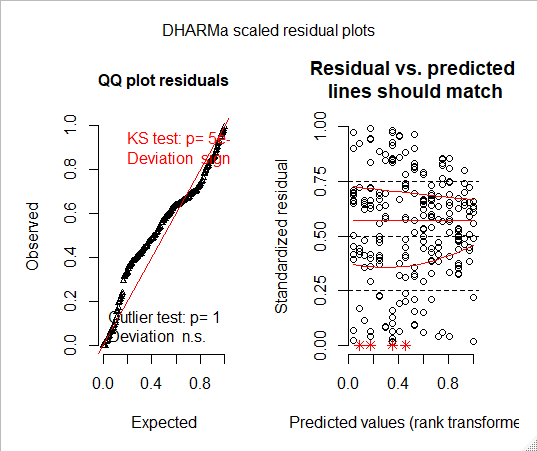I have percentage data so I am using a beta distribution and I want to do a mixed-effect model so I am still trying to decide between glmmTMD or the brm packages. I saw somewhere that some distribution types are affected by overdispersion more like Poisson however they said Beta isn't that much of a concern (is that true?). For the glmmTMB, I have two models one is looking at just random intercept model and the other is looking at the random slope intercept
glmmTMB(Redecimal ~ Region+food+genus +Region:food + Region:genus + genus:food + (1|sample), family = beta_family(link = "logit"), data = REdata)
glmmTMB(Redecimal ~ Region+food+genus +Region:food + Region:genus + genus:food + (1+food|sample), family = beta_family(link = "logit"), data = REdata_with_Pro_NA)
When I run the summary for these models I get very different overdispersion parameters. For the random intercept model I get a score of 26.9
Family: beta ( logit )
Formula:
Redecimal ~ Region + food + genus + Region:food + Region:genus +
genus:food + (1 | sample)
Data: REdata_with_Pro_NA
AIC BIC logLik deviance df.resid
-670.3 -608.3 353.2 -706.3 214
Random effects:
Conditional model:
Groups Name Variance Std.Dev.
sample (Intercept) 0.05991 0.2448
Number of obs: 232, groups: sample, 48
Overdispersion parameter for beta family (): 26.9
and for the random slope model I get a crazy high number (also warnings about convergence but that's another problem since I am missing data for one group
Family: beta ( logit )
Formula:
Redecimal ~ Region + food + genus + Region:food + Region:genus +
genus:food + (1 + food | sample)
Data: REdata_with_Pro_NA
AIC BIC logLik deviance df.resid
NA NA NA NA 200
Random effects:
Conditional model:
Groups Name Variance Std.Dev. Corr
sample (Intercept) 0.3329 0.5770
foodHNA 0.7688 0.8768 -0.63
foodLNA 1.0893 1.0437 -0.59 0.82
foodPro 0.3381 0.5815 -0.67 0.61 0.51
foodSyn 0.6385 0.7990 -0.68 0.55 0.45 0.79
Number of obs: 232, groups: sample, 48
Overdispersion parameter for beta family (): 1.42e+08
then I was using the DHARMa package
res <-simulateResiduals(glmmtbm, plot = T)
testDispersion(res)
for the intercept model score 26.9 I got these plots
DHARMa nonparametric dispersion test via sd of residuals fitted
vs. simulated
data: simulationOutput
ratioObsSim = 1.1623, p-value = 0.008
alternative hypothesis: two.sided
and then for the slope model which had an overdispersion value of 1.42^8 I got
DHARMa nonparametric dispersion test via sd of residuals fitted
vs. simulated
data: simulationOutput
ratioObsSim = 0.99052, p-value = 0.92
alternative hypothesis: two.sided
I am confused at why the intercept model that had a much lower value for the overdispersion parameter was significant using the DHARMa package and the slope model was not. My main question is should I worry about the value for beta distribution and if so what should I do. This is my first time trying to do any generalized mixed-effects modeling. And also for the brm package how would I go about testing it for overdispersion since the summary doesn't give a parameter value like glmmtmb




